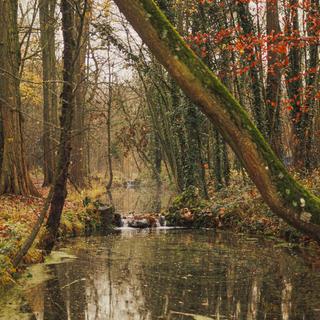


Discovering Paris's Bois de Vincennes with mycologist Marc-André Selosse
FeatureBiologist Marc-André Selosse first found his passion in this large Paris region forest. He explores the wildest part of the wood, in search of polypores, leucopaxillus and other treasures.
One balmy December morning, biologist and naturalist Marc-André Selosse pedaled briskly toward the Bois de Vincennes, boldly weaving in and out of the dense traffic around the Porte Dorée, in eastern Paris. The rumble of the périphérique, Paris' ring road, echoed in the distance. This professor at the National Museum of Natural History (MNHN) knows the paths by heart and, like many Parisians, has been coming to these woods since he could barely walk. As he sped along Avenue Daumesnil, his face lit up at the sight of the iconic rock of the Vincennes Zoo. This towering rock has loomed like a totem over the capital's largest public park since the 1930s. "I used to come here with my grandfather on the number 56 bus. I remember the great sense of joy I felt just at the sight of these huge stones," he said. The Bois de Vincennes is a remnant of the ancient ring of forests that surrounded old Lutetia – the Roman name for Paris. Once a royal hunting ground and then a military zone, it was finally given back to the people for their enjoyment after the Second World War.
The biologist ventured into the "wilder" part of the woods, where sidewalks turn into paths. It was here that he experienced his first profound moments with nature. "I was just over 10 years old, in the 1980s. My grandfather and my parents took me to the Bois whenever they could, on Wednesdays and weekends. Now I don't care about the merry-go-round, although it's not far away. My natural science teacher asked us to bring back mushrooms for the class. I got into the spirit of it," he said. Suddenly, he stopped to watch a magnificent jay poised among the oaks, about to take flight. "This granivore forages on the forest floor in winter," he explained.
Guided by his childhood memories, the naturalist walked along a path called the Route Brûlée, or "Burnt Road." He pointed his finger at a particular spot among the trees, away from the main trail: "That's exactly where I found my first Golden Scalycap!" he proudly declared. It was this mycologist's first hunting trophy. He immediately stated the scientific name of this catch: pholiota aurivella. This uncommon species of mushroom is not edible, despite its appetizing russet-tinged yellow color. "At the time when I found it, there was a huge felled oak on this spot. To reach the dead tree, you had to go under the foliage of a very large elder tree. There were thickets all over the place," he remembered in detail.

Over 40 years later, a small white igloo tent stood where the "sacred" golden scalycap once did. Nearly 140 homeless people live in the Bois de Vincennes. That morning, the makeshift camp near the Route Brûlée appeared deserted. A Red Cross vehicle patrolled nearby. "This precarious settlement in the heart of the woods has been here for some 15 years now," said the researcher.
You have 65% of this article left to read. The rest is for subscribers only.
